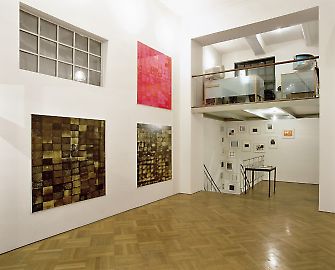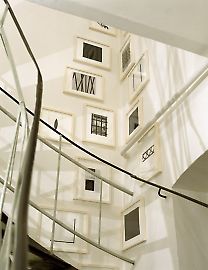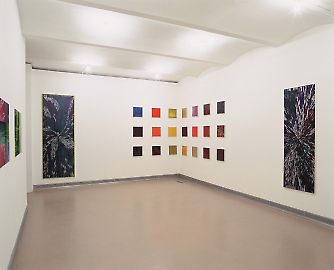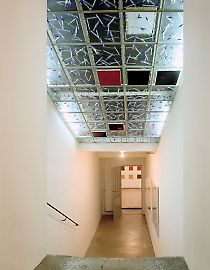Herbert Hinteregger --
Sometimes monochromatic, or oscillating and glowing in two or three colors: the often square, but sometimes very narrow rectangular canvases of Herbert Hinteregger. […] Dabs of paint, smears, irregular grids and grills, but also dots, and paint runs that in light of the puzzling character of these images evoke associations of landscapes, lakes, mountain formations. […]
In the early 1990s, the young avant-garde discovered understatement as part of techno and rave culture and formulated it in Crossover. […] The cult around everyday culture reflected what became the dominant practice in music: the creative recourse to pre-existing or found material and its rearrangement or alienation through sampling, cutting, remixing, and in addition the recourse to spaces that up until then had been denied the blessing of official culture.
Herbert Hinteregger’s works would be inconceivable without this backdrop and this mentality. Just as his after-image memory of the moors of his childhood form one system of reference—intimate, private, but made public in painting—the youth culture of the 1990s, similar to the television images that Herbert Hinteregger has running as he works, represents one of the central media and public systems of reference for his work. […]
While in his studio work, beginning in 1993–94, he concentrated first on paper works, and then on mid-sized canvas works, exploring the possibilities of the drawing and painting tool of ballpen ink in terms of composition, application, and structure, when invited to participate in exhibitions he hardly ever shows the works he works on in the studio. Instead he grants [...] a view of the conditions and processes at the root of his drawings and images. Squeezed out ballpen cartridges, cardboard boxes that at some point were filled with a dozen BIC pens; sponges from gas stations, drawn on records, empty ballpen casings with cap, or simply notes written with ballpen on the wall. […]
One of the most radical formulations of his art stands like a manifesto at the start of his career: three untreated canvases that he subjected in Tyrol in the Hotel Bad Habits for an entire winter season to the stuffy air of a bar. Here, sensuality confronts reduction, concept and painting, precision and openness in a pure form.
Johanna Hofleitner, "Raving Pictures – Über die Arbeiten von Herbert Hinteregger,“ in: Parnass, 1 (2001), S. 88-93.





